Note: The following article contains major spoilers for A Plague Tale: Innocence and mild spoilers for Harry Potter and the Deathly Hallows.
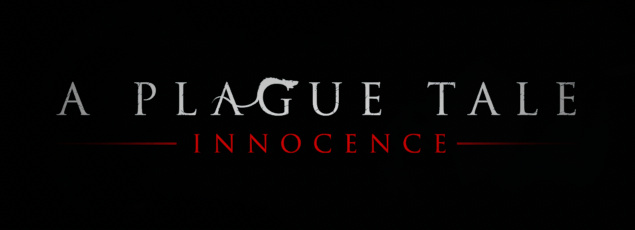
Do you know what game realises its world brilliantly? The first half of A Plague Tale: Innocence. As its title suggests, Asobo Studio's action-adventure tells the story of its protagonists losing their childhood naivety to a cruel and blighted adulthood. To maximise the change these characters undergo, it has them start from a sheltered and privileged background, yanks the bedsheets off of them, and then expels them into one of the grimmest times and places in human history: Aquitane, France, in 1348.
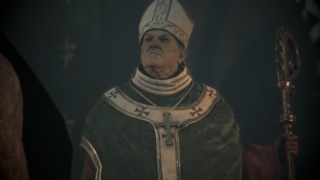
In the mid-14th century, a trio of demons beset France. For decades, the Inquisition had been sweeping through French population centres, raining down righteous vengeance on whoever they judged insufficiently God-fearing. In 1307, they'd tortured 15,000 Christian soldiers because even they fell below their standards of piety.[1] That subjugation compounded with the Hundred Years' War: an on-again, off-again military conflict between the English and French royal line. It originated from disagreements over who held the right to the French throne and the fiefdom of Aquitane.[2] And, not to be underestimated, there was the black death. Its symptoms included fever, vomiting, and joint pain. Four of five people who contracted the bubonic form died within eight days.
Smack dab in the middle of this strife, Asobo drops Amicia, fifteen, and her brother, Hugo, five. They belong to the fictional de Rune noble family. Hugo suffers from a hereditary illness that gives him painful headaches. His affliction may have been inspired by the genetically-inherited haemophilia that affected the real British, Spanish, German, and Russian royal families. Hugo's mother, Beatrice, toils away on alchemical experiments, seeking a cure for him. There are a lot of games about characters entering into dark settings, but sometimes they fail to express what their subjects have lost on their entry. Their stories and art don't present a brighter "before" world to contrast the harsher environment. A Plague Tale does, which allows it to pull off a wonderful "crossing the threshold" moment.
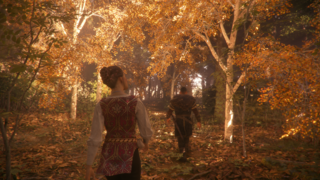
Amicia de Rune, her father, Robert, and their dog, Lion, spend a relaxed afternoon in the forest, and it is a beautiful forest. Its radiant autumnal foliage suggests a pleasant period in the family's life that is coming to an end and evokes the idea of death, with the characters soon to enter the more desolate season of winter. When Lion runs ahead of the duo, Amicia follows, passing over a well-defined line between the oranges and yellows of the living woods and a desiccated, grey wasteland. The aesthetic shift extends to the game feel as we go from sprinting carefree across the firm forest floor to plodding through thick mud.
We find Lion lodged in a hole in the ground, and something underneath him devours him alive. He barks. In horror convention, the first kill is the breaking of a taboo. It is a baptism in blood: an omen that the death of other characters is about to follow. Sure enough, once A Plague Tale breaks this seal, it's all violence from here on out. An epidemic is coming for who Amicia and Hugo love.
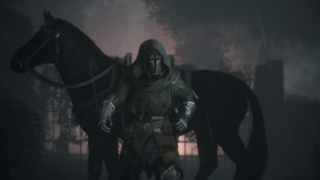
After a brief interval of peace at Castle de Rune, the Inquisition storm in, for some reason searching for Hugo. As Beatrice tries to sneak Amicia and her brother out of the home, the agents kill Robert and interrogate, then slaughter, the servants. This chapter forms the game's tutorial, and tutorials usually lack narrative or ludological gravitas. They're typically not sections of a game proper but pre-flight checklists we must run through to get to the game. A Plague Tale is thinking about how the nature of a tutorial could align with its emotive goals.
A common approach when educating the player is to wrap them in cotton wool. Active mobs are changed out for wooden targets; pits that could be bottomless, you can climb back out of. Something like that. In Innocence's tutorial, you pass through a genuine stealth section in which enemies could turn around and kill you at any moment. Not yet knowing the AIs' cues or what distracts them, I found this intimidating. However, I had Beatrice's detailed instructions to fall back on. The gameplay invokes the protective element of her character; it mothers you. Implicit in this scene is how frightening it would be to play without Beatrice, and knowing how video games work, we're aware that abandonment is inevitable. It didn't surprise me to see the de Rune mother not make it out of the chateau; her children are forced to leave her to die at the hands of the church. To spare Hugo's feelings, Amicia tells him that their mother is still alive and that they will reunite soon.
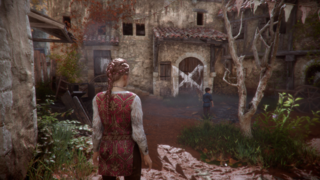
From their home, the de Runes flee to a pastoral village of tightly-packed houses. For the first half of the second chapter, Amicia implores locals to help her and her brother but is answered only by locked doors and empty streets. People refuse to leave their homes, the exteriors of many daubed with crosses: the mark of a plague house. This sequence makes solid the social alienation caused by pandemics. No doubt there are a lot of people dead from the disease, but it's also that the living are so scared of catching or spreading it that they decline any human contact. This burg is inhabited, and yet, it's a ghost town. The roads also wind circuitously and double back on themselves, so it's easy to get lost and spend a long time treading the cobblestones, fruitlessly looking for a human face.
The isolation reinforces these characters' loneliness now the Inquisition has taken their parents from them. The recent orphaning of the de Rune siblings also evokes the social distance that comes with quarantine. In fact, it was the plague from which we got the term "quarantine". To defend against these pandemics, the City of Venice required ships to sit offshore for forty days before their passengers disembarked. And the Italian for "forty days" is "quaranta giorni". It's also not a coincidence that the place A Plague Tale first has us encounter the sickness is a village. In towns and cities, population density is high, and as in this village, people at the time often lived in close proximity to animals, allowing the plague to spread efficiently.
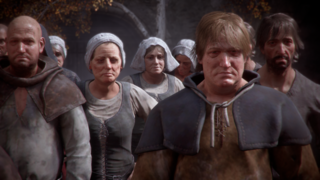
The bleak irony is that when Amicia does manage to find people, it leads her and Hugo to a worse fate. A mob of villagers have irrationally decided that the two brought the plague upon the town and that killing them will free them of it. Again, the game uses the plight of these children to talk about a real historical topic. The people of the late middle ages had no germ theory to understand the plague. Nor did they have the antibiotics to fight against it. From their perspective, they were living their normal lives one day, and a week later, vast swathes of people were falling terminally ill and dying in their beds.
To make sense of the chaos and provide the illusion of control, some Europeans turned to the explanation that those outside their religious or cultural circles were to blame. It was common for Christians to mythologise that Jewish people had seeded the black death by poisoning their food or water, and they responded with the mass torture and genocide of Jews. People manipulated the outbreak to confirm their prejudices about external social groups and used those strangers to turn a nebulous inhuman threat into a solid, identifiable adversary they could target.
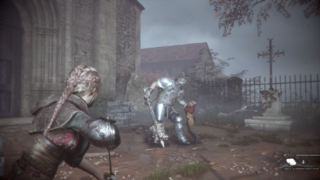
In a subversion of the usual relationship between protagonists and enemies, Amicia can kill a couple of the villagers with her sling but doesn't see it as a success. She's a fifteen-year-old and didn't come from a rough background. It hurts her to kill other people, but it's what she must do to survive. So, even winning these fights comes with an emotional toll. Like the first death in the story, Amicia's first kill is another seal broken, and similarly, becomes a precursor to more of the same. The chapter's boss is a man who has a borderline death wish, and there's no glory in killing someone in that state.
Despite depicting the reactionary paranoia that can surface during pandemics, A Plague Tale doesn't echo that same universal distrust. A kindly stranger saves Amicia and Hugo from the mob. Later, a monk will guide them on their way, and gradually, they will gather a ragtag band of other young people estranged from their communities by the outbreak. Unlike most fictional explorations of the black death, A Plague Tale is less interested in the direct agony and casualty caused by the malady and more concerned with the social fallout from it.
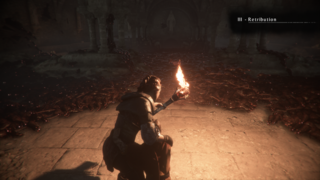
It's in Chapter Three that we come face to face with the plague, or at least, as face-to-face as you can get with an illness. The de Rune children travel into crypts below Aquitaine to escape the torches and pitchforks. But a cool, dark, enclosed space? That's the perfect breeding ground for rats. Although, rats may not have spread the plague. The plague is caused by a bacterium called Yersinia pestis, which can be carried by fleas or spread via bodily fluids like saliva or through infected tissue. But for years, studies have challenged the perception that there are detailed historical sources to show the fleas primarily travelled via rodents. Computer simulations suggest humans were the primary vector for the bacteria, directly or indirectly.
Still, A Plague Tale finds rats to be a useful symbol in the same way plenty of other art about the plague has. Bacteria are too small to be seen by the naked eye, a limitation for cinematographers and storytellers. The threat goes invisible unless you can chain it to an organism large enough for people to see, and that's what the rats are for. But while the vermin are the game's title antagonist, they don't constitute an enemy in the traditional game design sense.
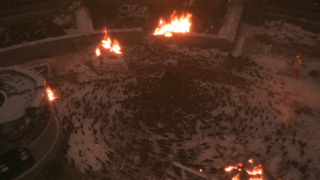
They're less individual entities and more an amorphous kill zone like the lava in Earthworm Jim or the "Corruption" in Waves. You can pick out single rats in the pack, but they're driven by something closer to fluid dynamics than what we typically label AI. You also can't ever "defeat" the rats. At best, you can avoid them or use light sources to usher them to the corners. Like the plague rapidly overtaking France, the rats seem to expand to take up any space you find them in. Like the disease, they cannot be contained. At best, you can gingerly step around them.
In Chapter Four, the game finally makes good on that threat from the first level, having the Inquisition hunt us down in a stealth gauntlet. There's a tendency in modern espionage games to let the player sneak up behind foes and knock them out, but A Plague Tale doesn't care for that trend. It wants enemies that are more powerful than you. After all, they're full-grown soldiers, and you're just an aristocrat's adolescent daughter. The stage also doesn't want too many chances for you to breathe.
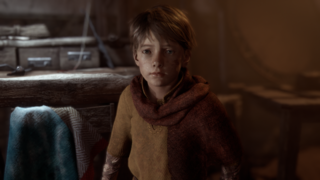
Amicia is eventually able to slip Hugo out from under the watchful eye of the church, but the boy's headache worsens to the point that we must carry him on our back. The reduced pace we move at as Hugo's mount brings our attention to Amicia's burden in trying to support herself and her young brother at her age. The game generally does a great job of giving us a brother-sister relationship with Hugo by lending him some characteristics of an independent entity and others that make him a limb of Amicia. We can command him to perform menial tasks during puzzles and must leave him somewhere safe while we tackle guards. He can also run off on his own, which draws worrying parallels to Lion in the prologue. However, when he holds our hand as we escort him, or in this sequence in which he rides on Amicia's back, our avatar effectively consists of both characters.
In Chapter Five, we cross one of the battlefields of the Hundred Years' War. There are a few living soldiers from the English army in these hills; the English did make some sizeable gains in the conflict in 1347, the year before Innocence takes place. However, the vast majority of the military we see are corpses, giving the impression that nothing meaningful has been gained, but plenty of lives have been lost. The corpses aren't just set dressing either. Amicia and Hugo are forced to come into contact with the reality of the war by literally wading through them.
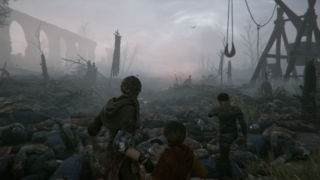
Many of the bodies are impaled with arrows, and there are bogs all over this level which can leave you a sitting duck for hungry rats. While the Battle of Agincourt, the most famous of the Hundred Years' War's clashes, took place 67 years after this game, there are parallels between it and the battle prior to Chapter Five. Torrential rain in the days leading up to Agincourt softened dirt into deep mud, which slowed French troops, allowing English bowmen to decimate them.[3]Archery came to prominence as a military art during the war, and historian Kennedy Hickman describes English archers as the "backbone" of the country's forces. See also the English's use of bows and arrows in their victorious battles at Crécy (1346) and Poitiers (1356).
Like the Chapter Five battle, Agincourt left plains of dead, with the English army murdering between 6,000 and 10,000 soldiers.[3] Innocence also relates the military engagements to the plague. The battle that preceded the de Runes' arrival has left piles of dead bodies that have attracted rats, aggravating the epidemic. As we tip-toe around this no man's land, Hugo gets kidnapped.
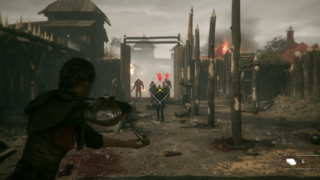
In Chapter Six, we infiltrate a camp to win him back. On the English's home turf, we have a chance to view the war from their perspective. You'll see more English archers here. There are also a couple of men among the tents denigrating King Edward III for continuing incursions into France, a reflection of the drawn-out nature of the war. By this point, it had been raging for eleven years.[2] At the end of this level, there's a sudden switch in power relations between our foes and us. The English army has agreed to hand Hugo over to the church. The troops spot Hugo, Amicia, and some of their newfound allies, and we are faced with a shooting gallery in which we must take out many enemies in quick succession. Amicia is dragged into the war, becoming a French soldier herself, and A Plague Tale features more action sections going ahead.
We often say that video games are better when we have distinctchoices about how to tackle problems. We sometimes treat immersive sims as guiding beacons in the medium because they will let us take a melee, shooting, diplomatic, or stealth path through a level. Yet, there are sections of A Plague Tale that hit home emotively because we are locked into one mode of engagement. If the game gave you the option of an action-first approach when you initially encountered the Inquisition, it wouldn't get across how the Catholic forces totally overwhelm communities. If it permitted you to stealth around the English soldiers at the end of Chapter Six, Amicia couldn't be metaphorically drafted into the war, a turning point in the loss of her innocence. But I'm sorry to say, this is about where A Plague Tale's dramatic spring runs dry.

From Chapter Seven onwards, the game has its moments. There's a level in which we play Hugo. It individualises him and gets to his complete lack of defence against the adult world. The camera is down at floor level with grown-ups hovering over you like the columns of a great cathedral, and you have no attack options to fend off anyone wishing you harm. In the back chapters, we witness a sadistic Inquisition storming into plague-filled suburbs, and the plot touches on faith as a medicine. Some people thought the disease was god's judgment for declining religious fervour. So, forcing people into deeper Christian devotion would be a cure.
It's also not that the front half of the game is perfect. The dialogue is unseasoned and embarrassingly obvious. A Plague Tale is the kind of media where if a character is cold and hungry, they'll say something like, "I'm frightfully cold and ever so hungry". But at least up to the midpoint, the game is giving a face to suffering in plague-era France. The further in you get, the more it betrays that mission for the sake of ahistorical and supernatural sensationalism.

We discover that Hugo and Amicia's mother, Beatrice, is still alive, and being held by the Inquisition. We free her and concoct her alchemical recipe to banish Hugo's increasingly debilitating symptoms. As it turns out, Hugo's congenital disease is actually a psychic power that lets him control rats. The Inquisition has been hunting him so that the Grand Inquisitor, Vitalis Benevent, can inject himself with the boy's blood and gain the same mind control. The final boss battle is a sort of Harry vs. Voldemort showdown where Hugo must use dark rats to defeat Vitalis's light rats. Hurricanes of the creatures fly across a nave's stone tiling while swirling columns of them slam down around Amicia. It couldn't be much further from where the game starts.
A Plague Tale's historical grounding constituted a form of remembrance for real victims of disease and slaughter. Even the game's visuals work to that end. Its textures have the pixel count to capture the grime in the corner of every basement and the weathering on every paving slab of the courtyards. They're indicative of a world that's been both incubated and been worn away by disease. And on top of the high-tech textures, models, and lighting, the reality of the game is held in the subtle variations between props.
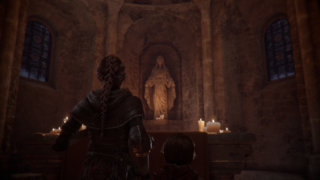
A Plague Tale is not as quick to copy-paste objects in the same orientations as its peers. It does reuse and recycle. A torch is a torch, a rat is a rat, and if you really stop and stare at the beams on the cottages, you can see the same splintering repeat from one to another. But there's also plenty of messiness and non-uniformity that helps us suspend our disbelief. Some of the chairs in the entrance hall of the de Rune villa have crimson cloth folded over them, and others don't. The columns at the back of the church in Chapter Three each have their own unique abrasions. The plants in the prologue don't all coil back from the path; they jut out into our way at stochastic angles. The photographic style of Innocence affirms that its events are happening in the world that we know. That displaced 700 years, we would find ourselves in the shoes of these poor peasants and bloodied soldiers.
The game's collectables further describe the plague as it happened. They don't simply increase a counter or add side stories. They're everyday objects that come with a description of how they are relevant to history. When you collect the soaps, you can read a short blurb on these toiletries' increasing commonality in Europe at this time. People reacted to rampant disease with more stringent personal hygiene. Or there's the whip which the game tags with a short explanation of the flagellants. The flagellants were a religious order who engaged in public displays of self-whipping as a conspicuous religious penance. But the whips, now covered in decaying human flesh, became a health hazard, helping spread the plague. It's impressive the quantity of items the game links back to the disease and Inquisition without stretching, and it's proof of how much this thin sliver of history changed our world.

The story's refusal to negotiate with fictional rules is also why it was so grim. A Plague Tale's early setting doesn't have the theatric bravado of high fantasy. Not only is the average person likely to die in this world, but it won't be a glorious vanquishing at the hands of a legendary monster. The majority of people who perish in this setting pass away sitting in filth from the slow rot of disease, isolated from their family and community. Even those who fall to the Inquisition mostly get run through with a sword without any ceremony, and then the soldiers turn their sights on the next person. Death is not epic or heroic; it's indiscriminatory and meaningless.
As A Plague Tale burns off its realism, the look, collectables, and narrative setup left in its ashes don't speak to its new goal of being a sword and sorcery adventure. It even soils one of its most promising analogies. The symbology and ludonarrative had been working with this relatively sophisticated metaphor where, not only do the rats represent the plague, but they also represent the Inquisition, and vice-versa.

Both the plague houses and the Inquisition wear crosses. The Inquisition uses rats as its attack dogs. Amicia has a nightmare in which Vitalis corrupts Hugo, and at the moment he does, rats consume her brother. The Dr. Doolittle power Hugo sways the rats with is called "Imperium", referencing the Catholicism of the Holy Roman Empire. Like the plague rats, the Inquisition surges across the country, hollowing out towns and massacring the populace; they are a disease to Europe. The rats and the Inquisition prescribe a narrow path for you to walk, and if you step even a foot out of line, they will eat you alive. But this read on the game loses its coherence once you see that the rats can work against the Imperium and that there are good rats and bad rats.
This hard right into fantasy also takes characters with heartbreaking odds stacked against them and gives them an easy out. Much of the peril in the story came from the fact that the plague and military forces are everywhere and are ruthlessly effective at killing. The black death had a mortality rate of about 80%, so it feels like it will take a miracle for Hugo and Amicia to make it out alive. But a miracle is what they get via restorative potions and magic spells. In general, the game is of two minds about how inhospitable its setting is. On the one hand, you have the hostile and indifferent world that would burn a five-year-old's home to the ground and destroy communities with disease and religious persecution. On the other hand, the setting has a just-so quality that destines success. A little boy's fantasy of the Inquisition sparing his mother comes true, and even the might of a plague can melt to convenient coincidence. When our path appears to be blocked, there's always a brazier we can light in just the right spot to scare off the rats or a flower bed right where we'd need some cover from patrolling troops. It's a contradiction in the design of many darker AAA games.
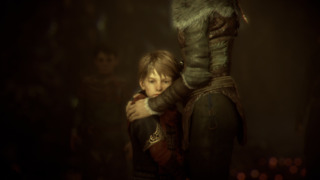
The real people of the Middle Ages had a far more horrendous future ahead of them. The Catholic Church would dispatch Inquisitions for almost five more centuries. Its vilest, the Spanish Inquisition, would kill 32,000 people.[1] The Hundred Years' War actually sustained for 116 years of bloodshed.[2] That would be like if we'd been at war since 1907. An estimated 25 million people succumbed to the plague, almost a third of the population of Europe.
In its epilogue, the game claws back a little of the solemnity in that history. At first, the final chapter looks childishly rosy, as though Amicia and Hugo haven't suffered any substantial loss. The siblings visit a fair, and those skills that Amicia once used to kill, she turns to a carefree carnival game. But then the two try to enter the town's main square and are denied because they're still wanted by the Inquisition. Rejected from the festivities, they leave town with their mother on a horse-drawn cart. They laugh and tease each other as they disappear into the distance, but where the game started in a vibrant autumn, the wagon now appears tiny against a snowy landscape of dead trees. The world they continue into is much more lifeless and unforgiving than the one they started in. Thanks for reading.
Notes
- Inquisition by History.com Editors (Jan 10, 2023), History.
- Hundred Years' War by History.com Editors (Aug 21, 2018), History.
- 9 Things You May Not Know About the Battle of Agincourt by Evan Andrews (Jan 2, 2019), History.
All other sources linked at relevant points in the article.
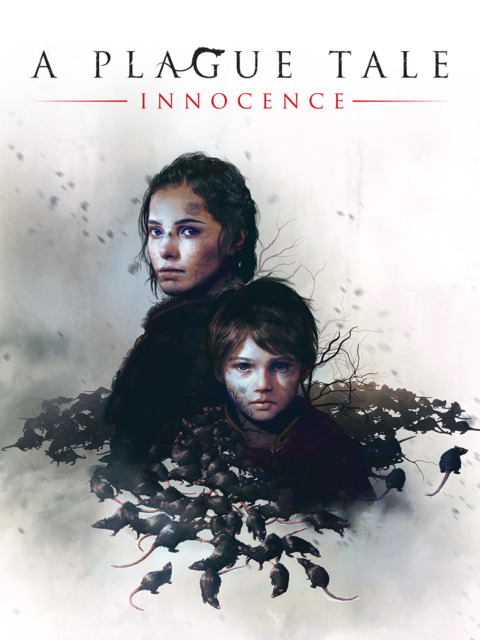
Log in to comment